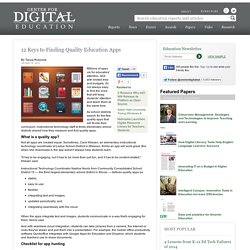

13 Ways To Use iMovie In The Classroom. Is there an app for that?

Well, chances are there are dozens of apps for anything you want to do, but sometimes you find one app that is robust enough to have multiples uses for you and your students. For me, iMovie is that app. I find myself using it for everything from slow motion videography to documentation, to presentations and everything in-between. Below are 13 ways that I have used iMovie (or have heard of others using iMovie) with students to enhance learning.
Documentation: Use the camera and microphone to record student work and performances. Peer Feedback: Use video as a great medium to get students to begin to provide each other with feedback. Self Reflection: Students learning to be self aware and provide self-feedback is one of the most effective things we can teach our students. Creating Movies: Youtube is the most popular and powerful search engine for kids, it is how they communicate. Professional Growth: Even as teachers, we can be using iMovie to learn. 13 Ways Annotated Bib. All cosmetology apps for iPad - iPhone - cosmetology. iPad Cosmetology Apps. 12 Keys to Finding Quality Education Apps. Millions of apps vie for educators' attention.

And with limited time and budgets, it's not always easy to find the ones that will keep students' attention and teach them at the same time. As school districts search for the few quality apps that will fit into their curriculum, instructional technology staff at three elementary school districts shared how they measure and find quality apps. What is a quality app? Not all apps are created equal. Sometimes, Carol Kliesen, an elementary instructional technology coordinator at Ladue School District in Missouri, thinks an app will work great.
"It has to be engaging, but it has to be more than just fun, and it has to be content-related," Kliesen said. Instructional Technology Coordinator Nadine Norris from Community Consolidated School District 15 — the third largest elementary school district in Illinois — defines quality apps as: When the apps integrate text and images, students communicate in a way that's engaging for them, Norris said. 12 Keys Anno Bib. Mae Jemison on teaching arts and sciences together. Mae Jemi Anno Bib. Fair Use Checklist. Introduction to the Checklist The Fair Use Checklist and variations on it have been widely used for many years to help educators, librarians, lawyers, and many other users of copyrighted works determine whether their activities are within the limits of fair use under U.S. copyright law (Section 107 of the U.S.

Copyright Act). Fair use is determined by a balanced application of four factors set forth in the statute: (1) the purpose of the use; (2) the nature of the work used; (3) the amount and substantiality of the work used; and (4) the effect of the use upon the potential market for or value of the work used. Those factors form the structure of this checklist. Congress and courts have offered some insights into the specific meaning of the factors, and those interpretations are reflected in the details of this form. Benefits of the Checklist A proper use of this checklist should serve two purposes. The Checklist as Roadmap Further Information Creative Commons Simple requests to users.
Fair Use Anno Bib.